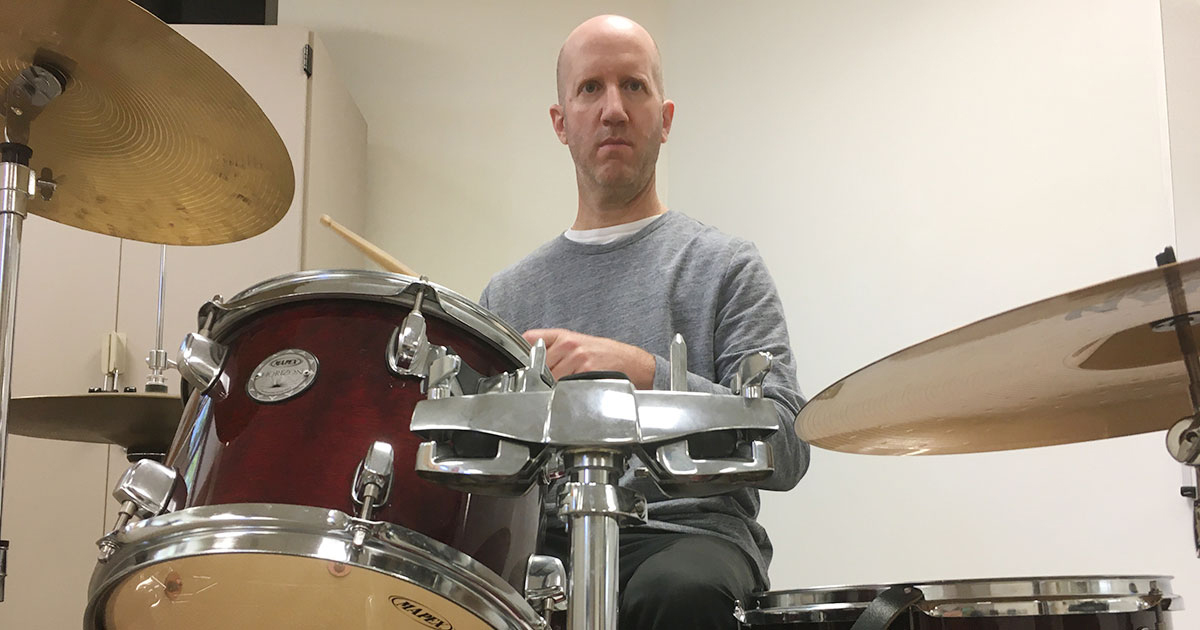Music therapist’s writings range from philosophical to practical

LAWRENCE – Bill Matney believes music therapists must sing and play a variety of instruments to have a complete toolkit to help their clients.
And as his scholarly publications show, the assistant professor at the University of Kansas School of Music takes a similarly wide-ranging interest in the field, from probing its deepest philosophical underpinnings to offering very specific instructions in his specialty, the use of percussion and the drum set.
In a 2019 issue of The Journal of Music Therapy, the field’s most prestigious, Matney published the article “A Knowledge Framework for the Philosophical Underpinnings of Research: Implications for Music Therapy.” Almost apart from the question of how music can be used to help clients — who often have a disability — move, learn and express themselves better, Matney writes about epistemology, or the philosophical study of knowledge, in relation to the different types of evidence and meaning music therapists generate through diverse research processes.
Matney writes of “the three primary epistemological positions that exist on a more nuanced continuum: objectivism, constructionism and subjectivism” outlined by Michael Crotty in his influential 1998 book “The Foundations of Social Research: Meaning and Perspective in the Research Process.” Matney offers, if not a critique, a re-envisioning of Crotty’s four-tiered “knowledge framework” that “emphasize(s) a two-way, dynamic relationship between” such fundamental questions as epistemology “and the research question(s). I also add surrounding factors in research process: the researcher, the context and the participant.”
Perhaps this questioning of long-held assumptions is to be expected at KU, which offered the world’s first graduate degrees in music therapy starting in the 1950s and also constitutes the field’s longest-standing complete program at the undergraduate level.
Matney himself became interested in music therapy after a youthful stint drumming in a touring rock band that, as he put it, drew respectable club crowds across the country but wasn’t a long-term career plan. His formal study of music eventually led him to music therapy.
Yet even now, long after he earned a doctorate and published a book on the use of drums and percussion in music therapy, Matney continues to draw on the experience of his first love behind the kit. His next article has been accepted for publication by the journal Music Therapy Perspectives and is titled “Drum Set Training in Music Therapy: A Resource for Students, Clinicians and Educators.”
Playing percussion instruments — including the drum set (consisting of snare, bass, cymbals and tom-toms) — in addition to guitar, piano and vocals is essential, Matney believes, for a music therapist’s toolkit.
“Through the use of body percussion, vocalizing/singing and other processes, the author proposes a way to promote a stronger understanding of how to use the drum set for accompaniment, re-creating, composing and improvising,” he wrote.
Matney outlines a method that allows students to practice by vocalizing and “percussing” various body parts (e.g., right hand taps left shoulder in place of the stick against the high-hat cymbal) so that, once they get in front of a drum set, muscle memory can take over.
Matney believes his methods seek to focus on instrumentation, musical development and clinical engagement relevant to music therapy practice, which is an improvement over a typical “percussion methods class where they're teaching you timpani and marimba and intermediate rudiments on a snare drum. There's very little of that that’s going to transfer into your clinical work.”
“So I've spent a lot of time over the last two decades looking at what percussion instruments music therapists use and how to teach those things in a way that they can transfer to their clinical practice. ... How do I use a drum set to facilitate certain kinds of grasps or range of motion for a client? How do I use a hand drum or a set of hand drums to promote social cohesion with a group of teenagers? These are the things I'm thinking about.”
Whether he is focusing on the specific or the general, Matney holds one fundamental view.
“First and foremost,” he said, “I am of the belief that all people have the capacity to be musical.”
Photo: Bill Matney at the drum set. Credit: Courtesy of Bill Matney